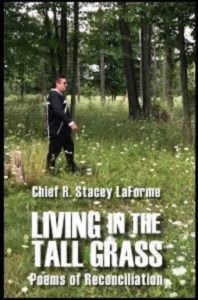Living in the Tall Grass – a collection of poetry by Chief Stacey LaForme
TORONTO—The Poet-Chief of the Mississaugas of New Credit, Stacey LaForme, had his first collection of work published by UpRoute Books and Media, an imprint of Durvile Publications Ltd. Living in the Tall Grass: Poems of Reconciliation was launched in December 2017.
The title reflects the fact that Indigenous people haven’t always lived where it’s easy, LaForme said in an interview in Toronto last month. “They live in the tall grass where it’s not always, ‘what’s for supper?’ Sometimes it’s, ‘is there supper?’ It’s not always manicured lawns – there’s weeds and bugs and snakes. On the other side of that though, the tall grass also says we remember our connection to Mother Earth.”
Being both a poet and a politician doesn’t always sit easily with him, but ultimately, the roles are complementary, LaForme said. “My poetry and the things I do have a very good reflection on Indigenous people as a whole and also raise the profile of the Anishinabek people, the Mississauga Anishinabek. The fact that I’m a Chief might raise some of my poetry.”
LaForme is not shy about sharing his writing. Anyone who has ever attended a meeting, conference or rally where he’s a featured speaker has experienced the Chief’s poetry. Most of his talks either begin or end with one of his poems.
“I use my poetry to connect with people,” he said. “So when I’m talking on a subject, I use it for the audience and they engage more with me and with the subject. It helps them remember the issues they were there to discuss…I’m very proud of the fact that it’s made some positive connections with people. I’m sure there are detractors out there who say that poetry has no place in the political world.”
LaForme’s writing style is one of profound and passionate simplicity. He makes no secret of the fact that he cares about all things Anishinabek and the ongoing struggle for justice and reconciliation. And while his poems contain hard truths, they also show his optimism because without hope, he said, “I wouldn’t be able to do my job. I’d have to quit.”
I look at it this way, he said, “There’s no justice for what happened to our people in the past. There’s no justice for attempted genocide. The best we can do is find a way forward. And finding a way forward means that today, we have to find justice. And if we can’t, then we can’t get to reconciliation. That’s just as plain as I can make it.”
Living in the Tall Grass is structured around the Seven Grandfather Teachings – honesty, truth, love, courage, humility, wisdom and respect.
“We’ve lived through so much and we’ve come through so much and it’s always been based on the philosophy of the Seven Grandfather Teachings.”
The first chapter; however, is titled Shkaakaamikwe (Mother Earth), because that’s the connection that’s most important to us, said LaForme. The six poems in this chapter speak to the love and nurturing of Mother Earth for her children. They also speak to the disrespect of some of her children who are too busy pursuing their dreams of wealth and comfort and material things. In the poem, Infestation, he boils it down to the following:
We torture the Earth day after day
So the car can go another mile, so we can
have a Big Mac
Chief LaForme firmly believes, “it’s not going to be the politicians or warriors that decide the future of Indigenous people.”
It’s going to be the artists, he said, because, “They’re the reasons that we’re going to have conversations and make progress that leads to understanding.”
Facts and figures are fine and they might make you feel bad for a while, he said, but you’ll probably forget it. “But, if you have a song, or a dance, or a story or a painting that really connects you, that moves you to tears, you’re not going to forget that. You’re going to associate that with the history.”
In his poem, Dancers, which appears in the Truth chapter, LaForme pays homage to artists, specifically to traditional dancers.
They touch the heart, tug at the soul
They are keepers of the past
A proud reminder of days gone by
They give us a glimpse of yesterday
And hope for tomorrow.
LaForme is already thinking about a second book. In the meantime, Living in the Tall Grass is available at indigo.ca, amazon.ca, or ask your bookseller to order it for you.


